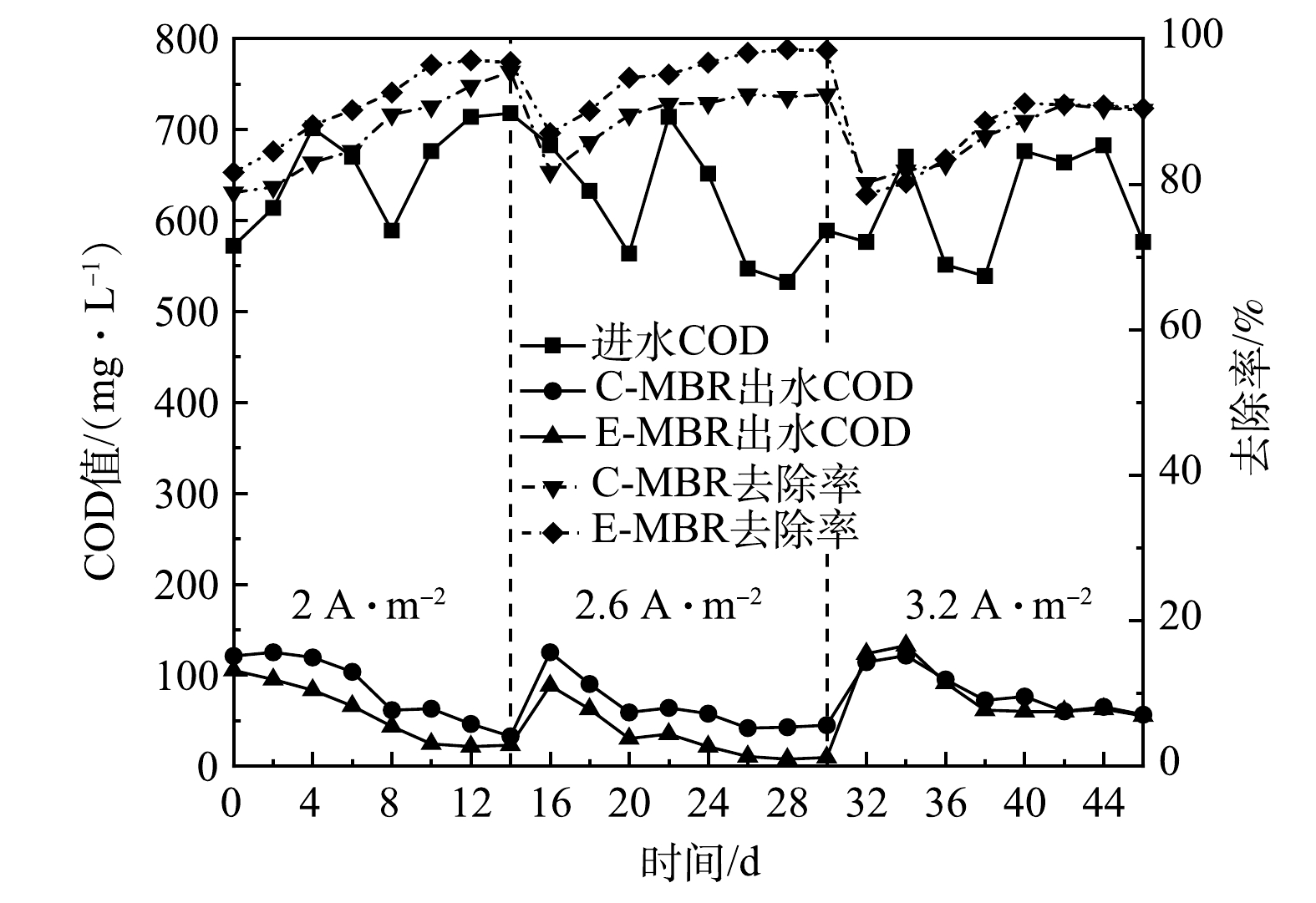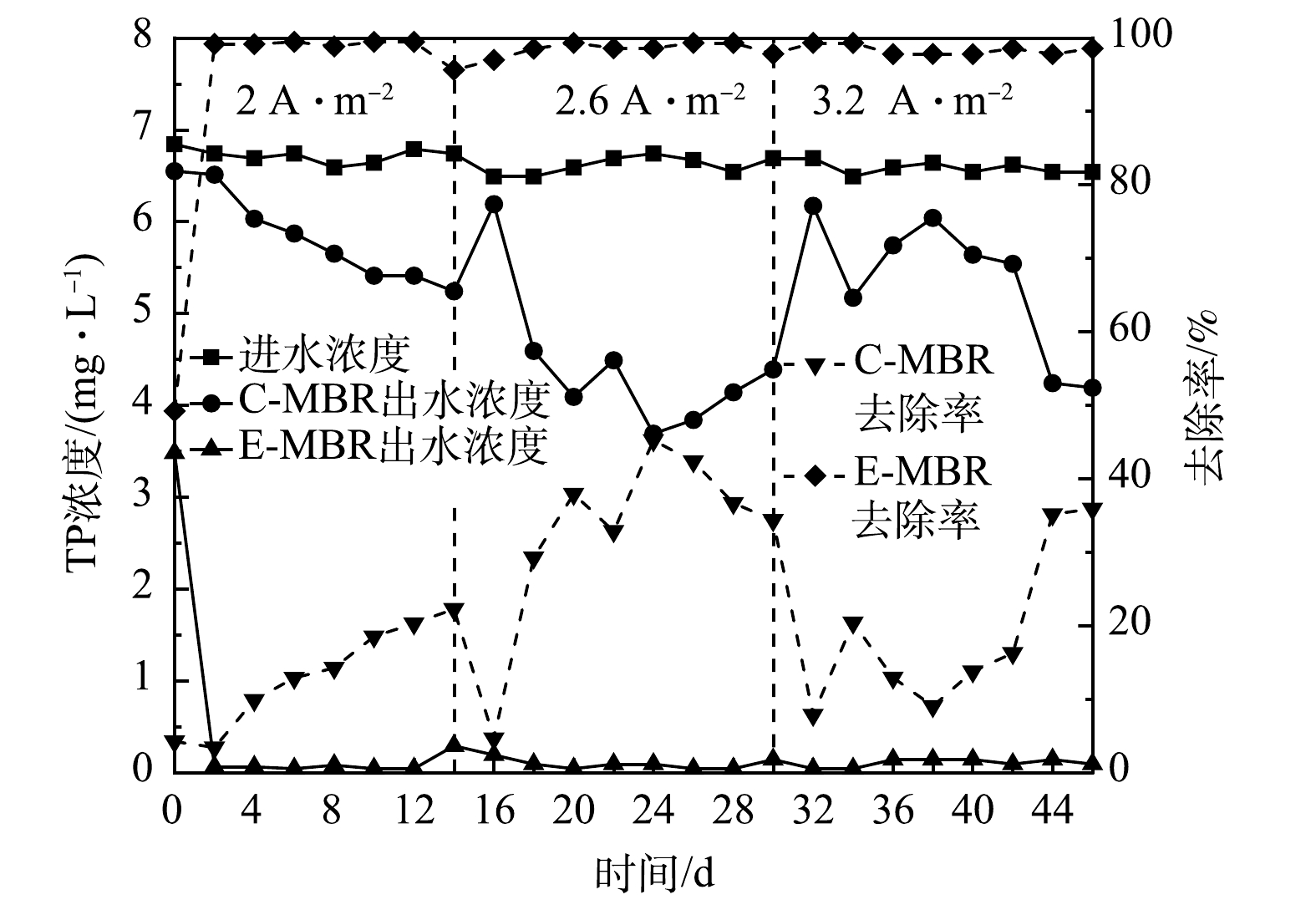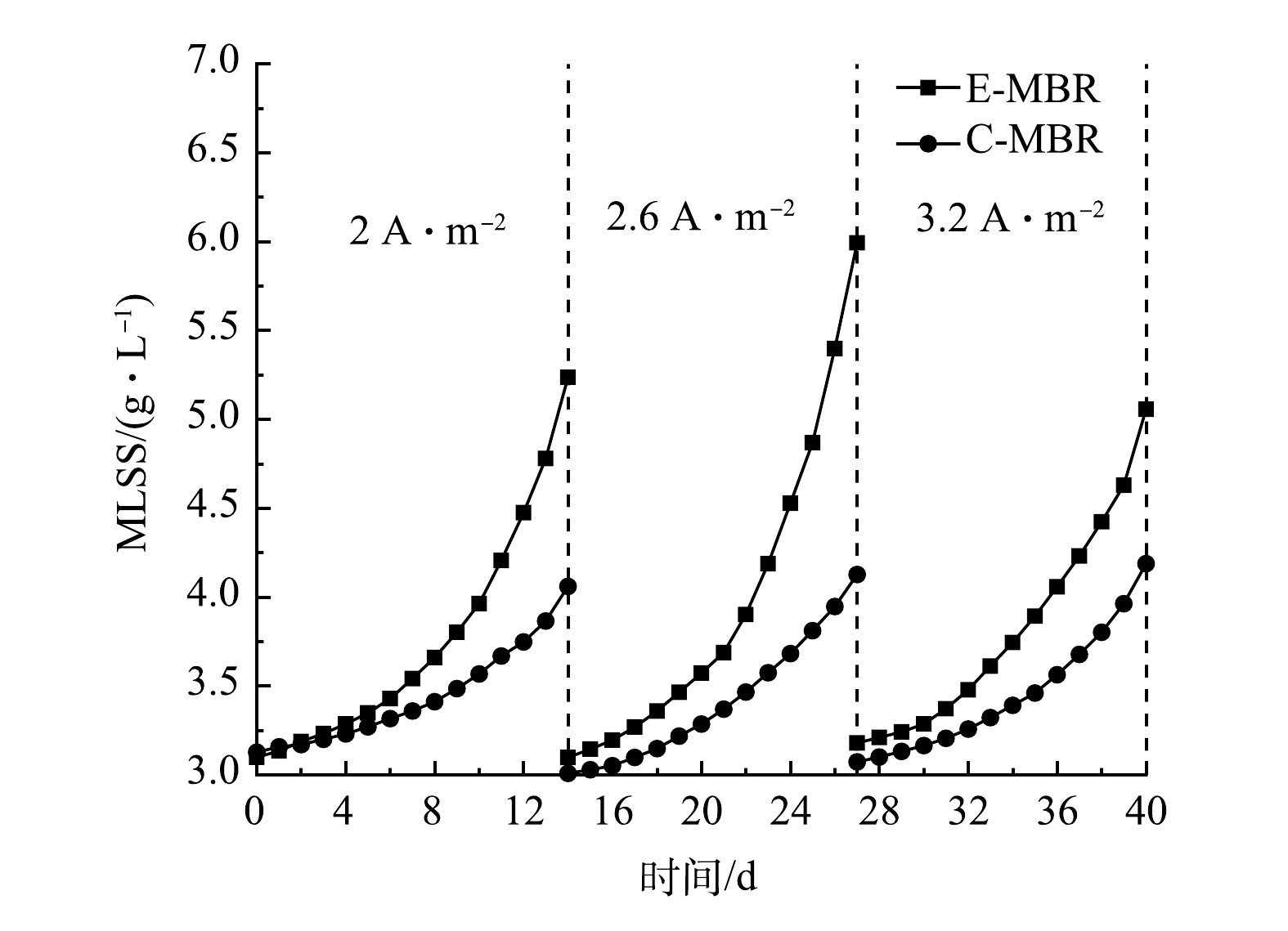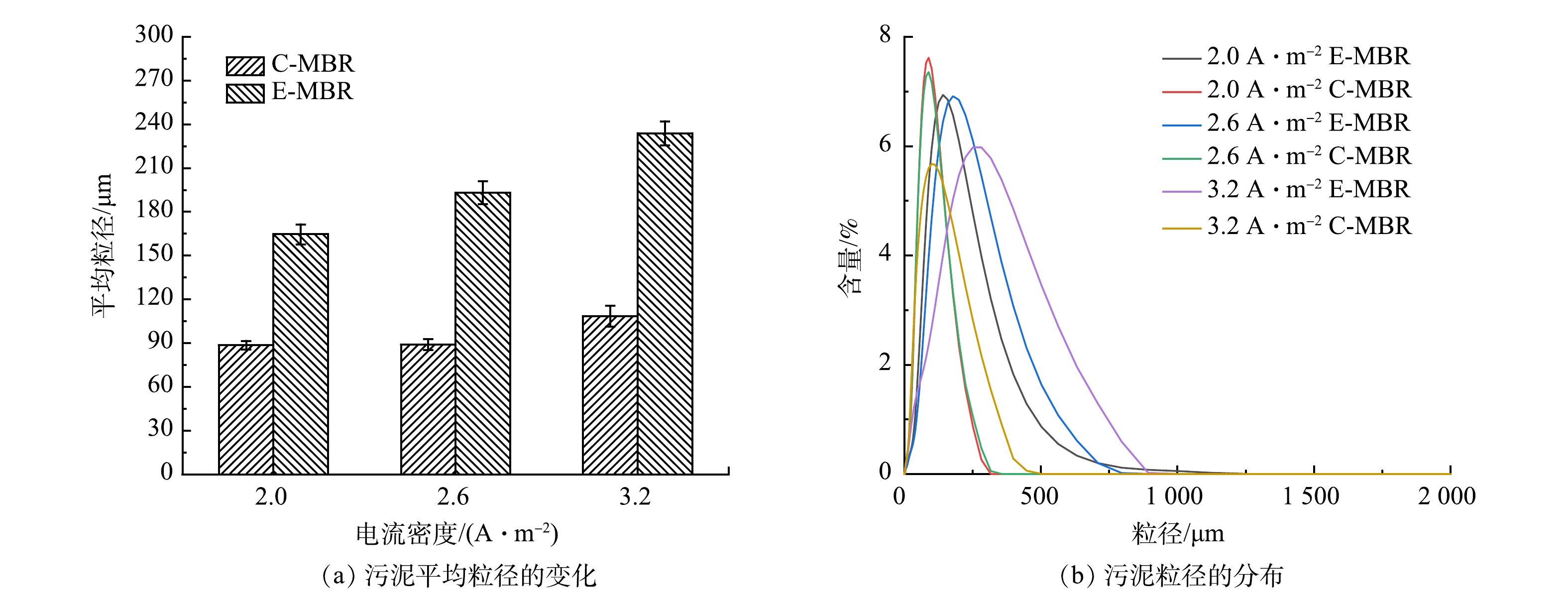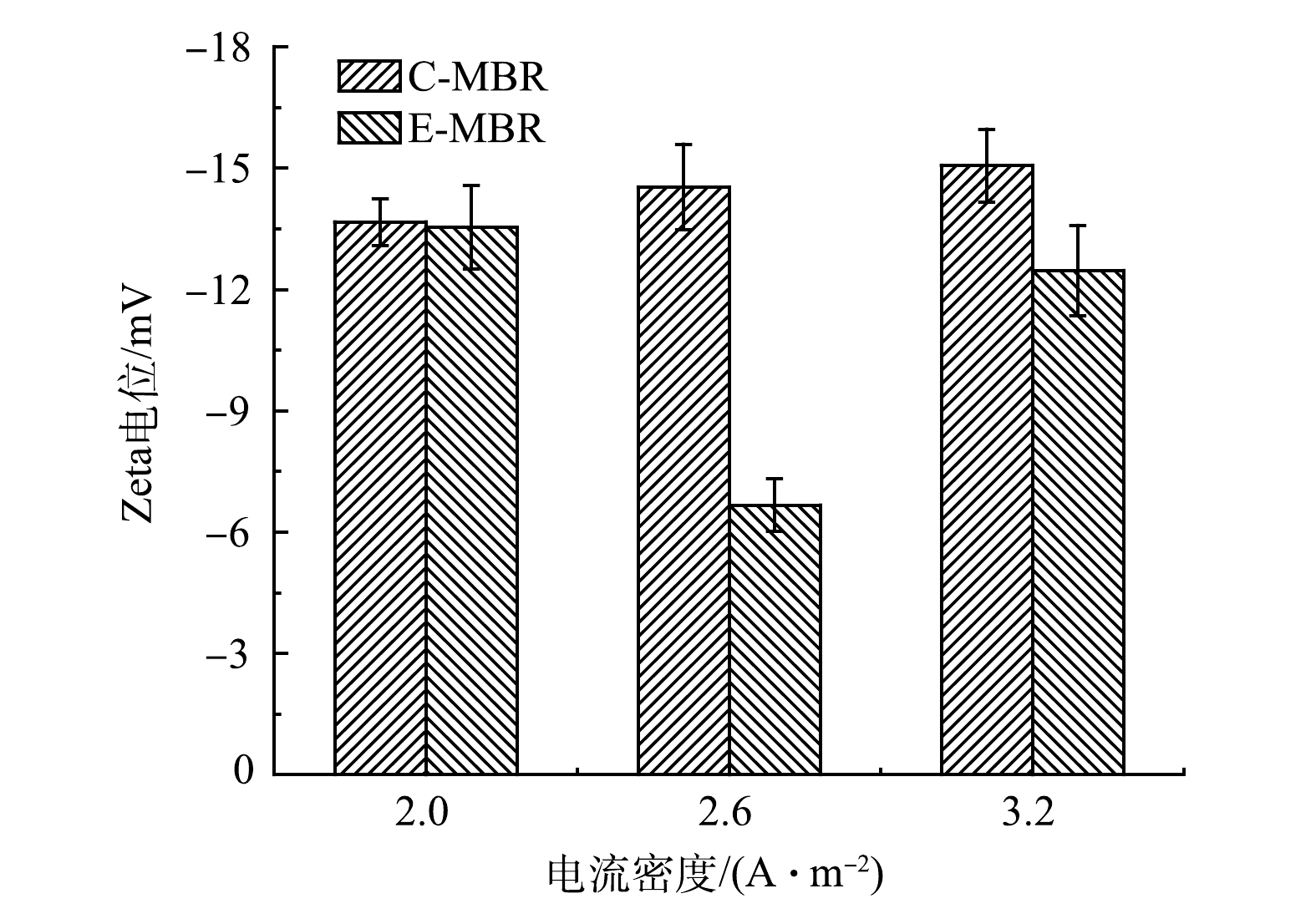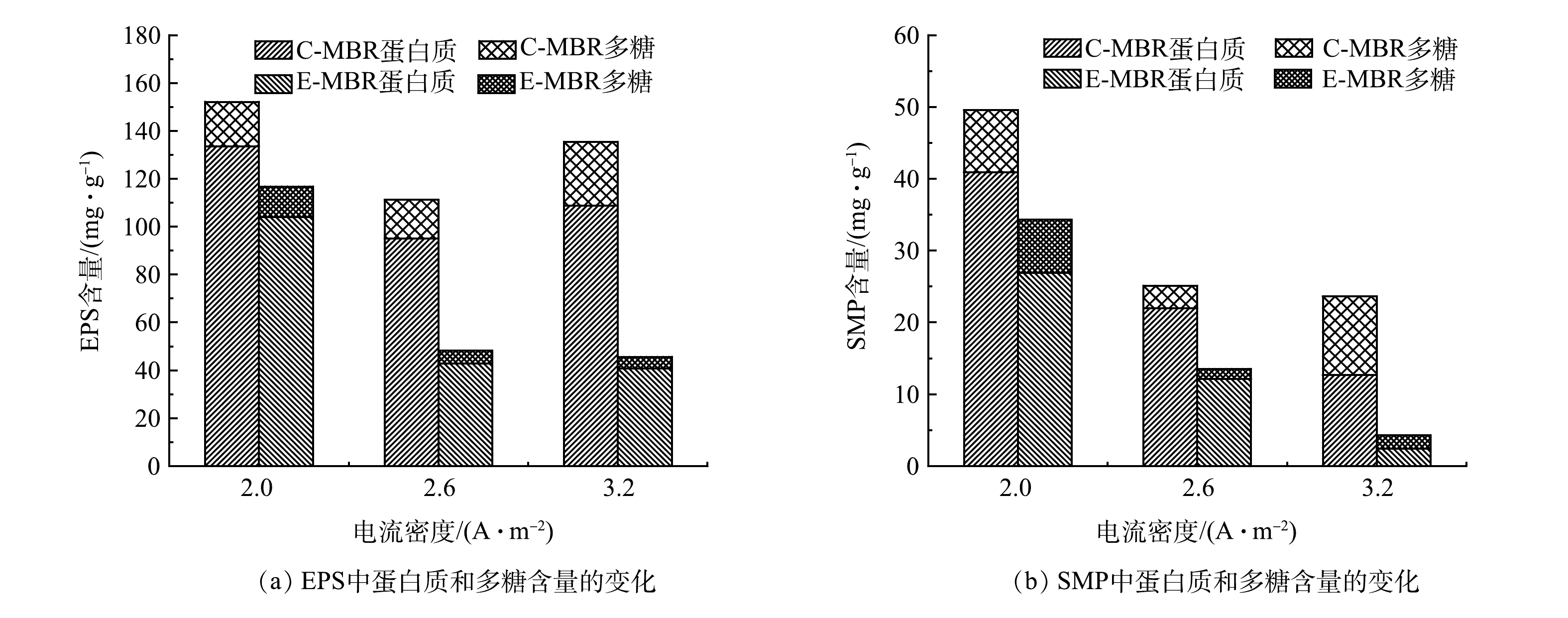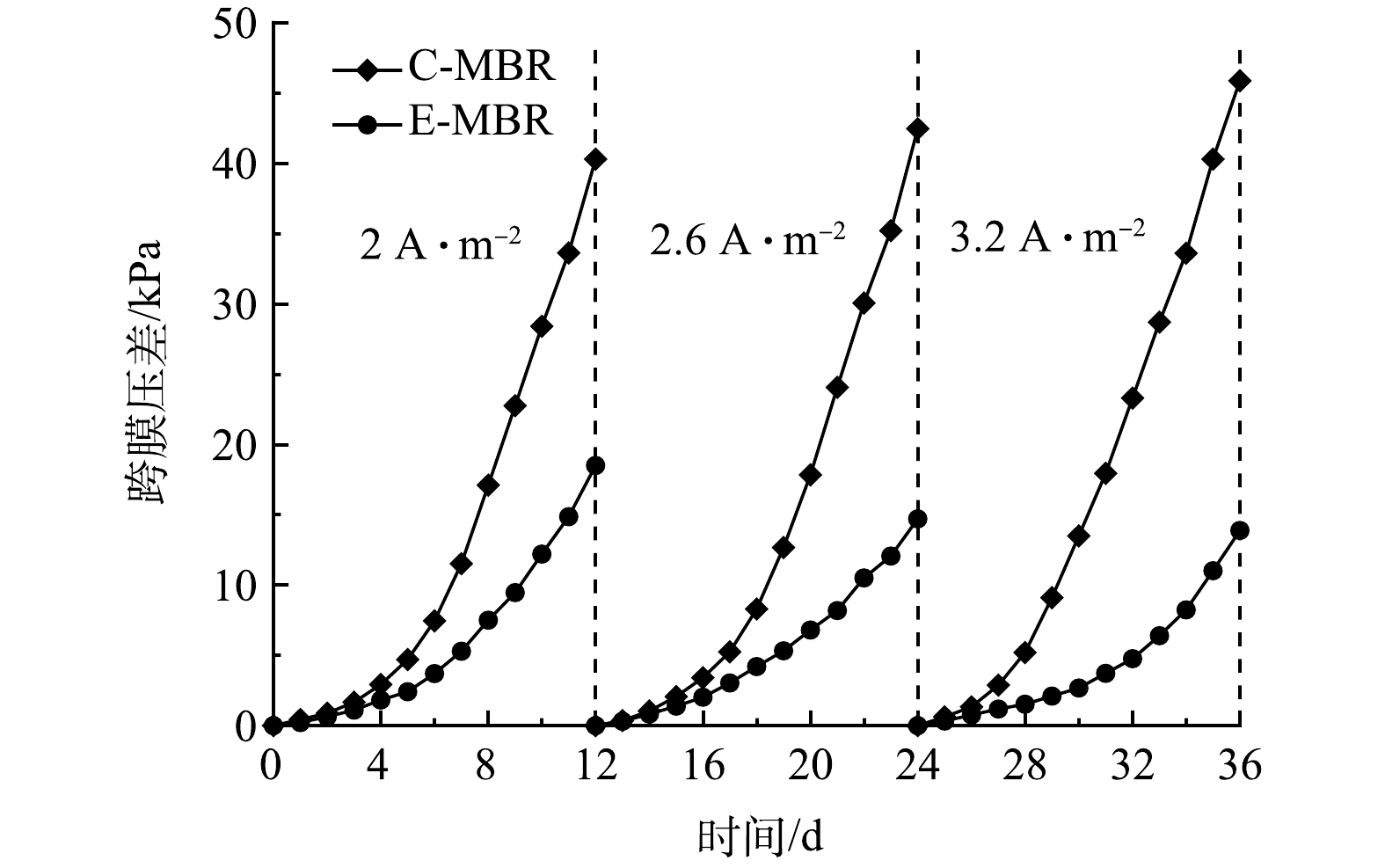-
近年来,越来越多的沿海地区采用海水淡化或海水直接利用技术作为缓解淡水紧缺危机的方法[1],而海水冲厕技术即为海水直接利用技术之一。使用海水冲厕可有效缓解我国沿海城市生活用淡水资源的供需矛盾[2],但采用此技术会产生大量的高含盐生活污水,给污水处理带来了巨大挑战[3]。有研究[4]表明,膜生物反应器(membrane bioreactor, MBR)对于处理高盐废水有较为显著的效果,MBR中的活性微生物经培养驯化后,能适应不同盐度的废水。ZHANG等[5]运用MBR工艺处理海水养殖废水时,当盐度由0 g·L−1增加到30 g·L−1时,MBR对COD和NH4+-N的去除率均保持在90%以上。然而MBR运行过程中产生的膜污染仍是影响MBR工艺稳定运行及阻碍其进一步商业化应用的主要因素[6]。
电化学MBR是近年来发展起来的新型污水处理技术[7],有研究表明,电场是缓解膜污染、提高出水水质的有效清洁的途径之一[8],其属于使用物化法控制膜污染的范畴,具有清洗效果好、过程稳定、无需外加化学药剂、没有二次污染、成本低等特点,可为拓展MBR的工程化应用提供技术支撑[9]。DUDCHENKO等[10]采用改性导电膜,建立了膜阴极MBR,发现在-3 V和-5 V下运行100 min时,TMP分别降低了33%和51%,外加电场可有效缓解膜污染。但外加电场的MBR系统应用于处理高盐废水的研究较少。本研究采用电强化的陶瓷膜MBR(E-MBR)处理模拟的海水冲厕水,通过与传统MBR(C-MBR)进行对比,考察了在不同电流密度下外加电场MBR系统运行性能、体系内活性污泥特性以及系统运行过程中膜污染行为的变化规律,以期为外加电场MBR处理含盐污水的实际应用提供参考。
-
E-MBR装置如图1所示。反应器采用有机玻璃材料,有效容积为12 L(20 cm×15 cm×40 cm)。膜孔径为0.1 μm的平板陶瓷膜置于反应器中央,采用双侧过滤,有效过滤面积为0.05 m2。钛丝插入膜组件中与直流电源的负极相连,作为E-MBR的阴极。2片石墨板阳极置于膜组件两侧距膜表面3.5 cm处,2块阳极板的有效面积均为0.025 m2。电极夹为铁质电极夹。进水由液位传感器控制,反应器液面低于设定的界面时自动进水。蠕动泵控制出水,保持恒定通量为20 L·(m2·h)−1,工作10 min,停止2 min,电场在出水停止时施加。另一个相同大小但是不施加电场的C-MBR与E-MBR平行运行,作为对照组。
本实验中1、2、3阶段设置的电流密度分别为2、2.6、3.2 A·m−2,对应的电流分别为0.1、0.13和0.16 A,每个阶段运行过程中保持电流恒定。反应器内接种污泥为驯化后适应10‰盐度污水的活性污泥,反应器内初始MLSS约为3 g·L−1,第2和第3阶段开始前会对E-MBR和C-MBR进行排泥,使得施加新的电流密度前2个反应器内的MLSS保持在3 g·L−1左右。进水为模拟海水冲厕水,组分为500 mg·L−1无水乙酸钠,400 mg·L−1 NH4Cl,30 mg·L−1 KH2PO4,pH为7.5~8(投加NaHCO3),10 000 mg·L−1海水晶,盐度和微量元素均由海水晶提供。模拟废水通过蠕动泵进入MBR中,经过膜组件过滤出水,出水采用蠕动泵抽吸方式,在恒定通量条件下运行。利用数字压力表记录TMP的变化,当TMP上升到40 kPa,取出膜组件,用海绵球擦洗并用去离子水冲洗膜表面滤饼层,如膜通量仍不稳定,用0.3%(体积分数)的NaClO溶液浸泡2 h,再用去离子水冲洗浸泡2 h并反冲洗5 min。
-
COD、NH4+-N、TP和MLSS均采用国家规定的标准方法测定,比氨氧化速率(SAOR)的测定方法参考文献[11]。采用激光粒度分析仪测定污泥粒径分布(particle size distribution,PSD),污泥混合液的Zeta电位采用Zeta电位分析仪(Zetasizer Nano Z,Malvern Instruments,UK)测定。SMP(soluble microbial product)和EPS(extracellular polymeric substance)是影响膜污染的重要因素。采用离心过滤法提取SMP,采用热提取法提取EPS[12]。上述提取物均经0.45 μm滤膜过滤,采用蒽酮比色法测定多糖含量,采用Folin-酚分光光度法测定蛋白质。通过膜污染过程中阻力分布分析,可以得出造成膜污染增加的主要因素。根据达西(Darcy’s law)定律公式可以得到膜总阻力RT,膜固有阻力Rm,膜浓差极化阻力Rcp,膜面滤饼层阻力Rc以及膜孔阻力Rb。
-
1)对COD去除效果的影响。如图2所示,当电流密度为2 A·m−2时,E-MBR系统运行初期COD的去除率为81.6%,略高于C-MBR的COD去除率(78.83%),经过一定的适应时间,E-MBR和C-MBR系统中COD去除率均可达到95%以上。但由图2可以看出,此运行期间,E-MBR系统COD的去除率均高于C-MBR。电流密度为2.6 A·m−2时E-MBR和C-MBR的运行效果与电流密度为2 A·m−2时的效果类似,E-MBR对COD的去除效果优于C-MBR,但在此阶段E-MBR中COD去除率达到90%需要的时间(2 d)短于电流密度为2 A·m−2阶段需要的时间(6 d)。由图2可知,在同样适应时间内,电流密度为2.6 A·m−2阶段的COD去除率要明显高于电流密度为2 A·m−2的阶段。第2阶段系统运行末期,E-MBR中COD去除率稳定在98%以上,略高于第1阶段末96%的去除率。其原因可能归为以下2点:适宜的弱电场对细胞代谢产生电刺激,提高微生物活性,促进了有机物的降解[13];随着电流密度的增大,体系中产生的具有氧化活性的物质浓度提高,进一步将有机物污染物降解为小分子有机物甚至矿化为二氧化碳和水[14]。继续提高电流密度至3.2 A·m−2,此阶段运行末期系统达到稳定状态,E-MBR系统COD的去除率稳定在90%左右,相较于前2个阶段有所降低。不同于前2个阶段中E-MBR对COD去除效果均优于C-MBR,此阶段E-MBR中COD去除率没有显著提高,与C-MBR对COD的去除效果相近。这是因为系统中污泥的活性在过大的电场作用下被抑制,从而导致系统中COD的去除率下降[15]。
2)对NH4+-N去除效果的影响。如图3(a)所示,在电流密度为2 A·m−2时,经过一段时间的适应,E-MBR和C-MBR中NH4+-N的去除率均可达到98%以上;当电流密度为2.6 A·m−2时,E-MBR系统在此阶段运行末期对NH4+-N的去除率达到了99%,高于此阶段下C-MBR系统95%的NH4+-N去除率。前2个阶段末期,E-MBR出水中NH4+-N的质量浓度均保持在1.5 mg·L−1左右,符合我国《城镇污水处理厂污染物排放标准》(GB 18918-2002)一级A标准[16],出水水质良好。第3阶段(电流密度为3.2 A·m−2),C-MBR对NH4+-N的去除率依旧良好,可达95%,但E-MBR对NH4+-N的去除率明显降低,平均去除率仅为88.33%,显著低于上一阶段96.37%的平均去除率。这是因为MBR中污泥的活性在过高的电流密度下被抑制,NH4+-N的去除率也随之降低[17]。
图3(b)为电流密度对微生物SAOR的影响结果。可见,随着电流密度的增大,E-MBR系统中SAOR呈先升高后降低趋势,当电流密度由2 A·m−2增加至2.6 A·m−2时,SAOR由(3.86±0.18) mg·(h·g)−1(以MLSS计)增加至(4.88±0.12) mg·(h·g)−1,升高了26.42%。电流密度升至3.2 A·m−2时,SAOR降低为(3.06±0.15) mg·(h·g)−1,相比于第2阶段降低了37.30%。上述结果表明,在适宜的电场强度范围内,增大电流密度可以显著提高系统中氨氧化菌活性,电流密度过大则会对氨氧化菌活性产生抑制作用。此结果与电流密度为2 A·m−2和2.6 A·m−2下NH4+-N去除效果显著高于3.2 A·m−2条件下NH4+-N去除效果的结果一致。
体系中氨氮的去除依赖于生物作用下的氧化作用和外加电场后产生的电氧化作用。膜的高效截留作用使世代周期较长的硝化菌和亚硝化菌在反应器内呈现出优先生长繁殖的趋势,并且避免了硝化菌的流失,硝化过程更完全,从而使膜出水的氨氮浓度逐渐降低[18];另一方面,在适宜范围内,随着电流密度的增大,电氧化作用相应增强,体系中产生的H2O2可以将NH4+-N氧化为氮气和水,促使污染物浓度降低[19]。
3)对总磷去除效果的影响。如图4所示,运行第1天时,E-MBR系统TP的去除率为49.22%,显著高于C-MBR对TP的去除率(4.22%)。第2天,E-MBR系统TP的去除率升至99.17%,此后TP的去除率一直稳定在99%以上。第2阶段和第3阶段E-MBR的TP去除率也一直维持在98%左右,远远高于C-MBR系统中TP的去除率。在第1、2、3阶段,随着反应器的运行,每一阶段末期C-MBR的TP去除率均稳定在35%左右。导致2个体系TP去除率差异如此大的原因可能归为以下2点:一是电场对聚磷菌生长的影响,电场作用下聚磷菌的活性增强——体系中产生的H2O2进入细胞体内分解产生大量O2,促进细胞的呼吸及氧化还原作用,减缓了对水分的吸收速率,与能量代谢有关的酶活性迅速提高,从而提高对TP的去除[20];二是电场作用下,阳极铁电极夹释放出的亚铁离子与混合液中的磷发生反应生成了不溶沉淀[21]。由图4可见,E-MBR系统电流密度增大至3.2 A·m−2时,TP的去除率并没有与上述COD和NH4+-N去除率在此阶段呈下降趋势相一致。这可能是由于菌种对电场的耐受差异决定的:去除磷的微生物与去除COD和NH4+-N的微生物对电场的响应情况、耐受程度不同,即在较高的电场强度下,去除COD和NH4+-N的微生物活性首先受到抑制,而去除磷的微生物活性依旧保持。
-
1)电流密度对污泥浓度的影响。考察了不同电流密度下2个系统MLSS的变化,结果如图5所示。电流密度为2 A·m−2时,C-MBR中MLSS由最初的3.13 g·L−1升至最终的4.06 g·L−1,增长了30%,此阶段E-MBR中MLSS阶段末比阶段初增长了69%。电流密度为2.6 A·m−2时,C-MBR阶段末比阶段初增长了37%,E-MBR阶段末比阶段初增长了93%。电流密度为3.2 A·m−2时,C-MBR阶段末比阶段初增长了36%,E-MBR阶段末比阶段初增长了59%。以上结果表明,施加适当的电场可促进MLSS的升高,电流密度为2.6 A·m−2时MLSS增长最快,电流密度为3.2 A·m−2时MLSS增长最缓慢。电场对污泥浓度的影响主要体现在电场对微生物活性的影响,适宜的电场强度作用下,体系中某些酶(脱氢酶、氨单加氧酶、亚硝酸盐还原酶、硝酸盐还原酶等)的活性增强甚至被激活,从而促进酶的生物活性反应[22]。适宜的微电场也可调节微生物代谢,使微生物细胞膜的通透性得以增强,营养基质离子的定向迁移在电场作用下被强化[23]。
2)电流密度对污泥粒径的影响。电场作用下污泥粒径的变化见图6。由图6(a)可以看出,各阶段E-MBR系统中污泥的平均粒径均显著大于C-MBR系统中的污泥粒径。施加的电场产生的电絮凝作用对污泥颗粒的最大影响之一就是促进污泥颗粒团聚[24]。在第1阶段,外加电场后污泥的平均粒径由对照反应器的89 μm增加至165 μm;第2阶段由89 μm增加至193 μm;第3阶段由108 μm增加至234 μm。进一步考察了各阶段2个系统中污泥粒径分布情况。由图6(b)可知,E-MBR中污泥粒径的分布更加集中,污泥粒径的分布可能更加均匀。均匀性可以通过污泥分散性指数(DSI)表征,DSI值越小,污泥分布越均匀。进一步计算两系统各阶段DSI值可得:电流密度为2 A·m−2时,C-MBR系统的DSI为0.931,E-MBR系统的DSI为0.815;电流密度为2.6 A·m−2时,C-MBR系统的DSI为0.908,比E-MBR系统大了0.062;电流密度为3.2 A·m−2时,C-MBR系统的DSI为1.08,E-MBR系统的DSI为1.072。这说明,外加电场后,DSI值降低,体系中污泥粒径的均匀性得到了有效提高。滤饼层阻力的大小是膜污染总阻力大小的决定性因素之一,滤饼层的形成与系统DSI的大小有一定关系,DSI降低,表明附着在膜表面的滤饼层阻力越小,形成的滤饼层越松散[25]。由此可知,外加电场后,较大粒径的活性污泥可以减少膜孔的堵塞,减缓膜污染的程度[26],同时污泥絮体均匀性的提高同样减缓了膜污染速度。
3)电流密度对污泥Zeta电位的影响。如图7所示,电流密度为2 A·m−2时,E-MBR系统的Zeta电位(绝对值13.53 mV)略小于C-MBR系统(13.67 mV)。电流密度增大至2.6 A·m−2时,2个系统Zeta电位的差值显著变大,C-MBR系统的Zeta电位为14.53 mV,E-MBR的Zeta电位为6.67 mV,下降了7.86 mV。电流密度为3.2 A·m−2时,C-MBR的Zeta电位为15.07 mV,E-MBR的Zeta电位为12.47 mV,下降了2.6 mV。电场降低污泥的Zeta电位表明电场的施加降低了污泥颗粒之间的排斥力,使得污泥颗粒更易团聚,较大的污泥颗粒更不易引起膜污染[27],这与前述电流密度对污泥粒径影响的结果是一致的。
-
1)电流密度对膜污染物质的影响。SMP和EPS是影响膜污染的重要因素。图8反映了不同电流密度下EPS、SMP中蛋白质和多糖含量变化的情况。两系统混合液EPS中蛋白质和多糖含量如图8(a)所示。电流密度为2 A·m−2时,C-MBR中蛋白质含量为133.62 mg·g−1(以MLSS计),多糖含量为18.48 mg·g−1;相较于C-MBR,E-MBR中蛋白质含量降低了22.16%(104.01 mg·g−1),多糖含量降低了31.01%(12.75 mg·g−1)。第2阶段,C-MBR中蛋白质含量为95.08 mg·g−1,多糖含量为16.08 mg·g−1;相较于C-MBR,E-MBR中蛋白质含量降低了54.94%(42.84 mg·g−1),多糖含量降低了66.54%(5.38 mg·g−1)。第3阶段,C-MBR中蛋白质含量为108.8 mg·g−1,多糖含量为26.61 mg·g−1;相较于C-MBR,E-MBR中蛋白质含量降低了62.63%(40.66 mg·g−1),多糖含量降低了81.47%(4.93 mg·g−1)。从各阶段2个体系EPS中蛋白质和多糖含量的对比结果来看,随着电场强度的增大,EPS中蛋白质和多糖含量显著减少,从而在一定程度上缓解膜污染。产生此现象的原因可能有以下2点:一是电场作用可以刺激微生物活性,增强微生物的代谢能力,使得微生物不需要再分泌更多的EPS来改变生存环境,因此抑制了EPS的生成[28]; 二是电场作用下体系中产生的具有高氧化作用的H2O2和·OH可以致使EPS的含量降低[29]。
系统中另一主要膜污染物质SMP中蛋白质和多糖含量的变化与EPS一致,E-MBR系统SMP中蛋白质和多糖含量随着电流密度的增大而降低。这可能是由于系统中施加了适当的电场,具有较高的有机污染物处理效率,减少了系统中活性污泥的有机负荷,从而降低了SMP中蛋白质和多糖的含量。
2)电流密度对系统TMP的影响。跨膜压差是反应膜污染程度的重要指标之一,跨膜压差越高膜污染越严重[30]。理论上,本研究E-MBR系统存在的电场作用会缓解膜污染情况,保持膜出水通量恒定。每个阶段TMP随时间的变化情况如图9所示。可见,每个阶段2个反应器TMP的变化均是由最初的平稳增长变为快速增长。在C-MBR中,TMP在运行前期略有增加,从第4天开始TMP迅速增加直至40 kPa。E-MBR中,从第6~8天开始,TMP的增长速率开始加快。每个阶段末期,C-MBR的TMP值分别为40.3、42.5、45.9 kPa,相对应时间下E-MBR的TMP值为18.5、14.7、13.9 kPa,分别比C-MBR降低了54.09%、65.37%和69.74%。对比3个阶段E-MBR系统TMP的增长,可以看出,电流密度越大,TMP增长越缓慢,膜污染缓解程度越明显。以上结果可以归因于以下3点:一是电场作用下,膜组件表面带负电,混合液中带负电的污泥絮体、大分子有机物或胶体在电场排斥力的作用下,向远离膜面的方向移动[31];二是附着在膜表面的污染物质会被混合液中电场作用下产生的H2O2和·OH等强氧化剂原位降解,膜污染从而得到缓解[32];三是电场作用下污泥性质发生改变,例如污泥Zeta电位变小,污泥粒径增大,这些均可以缓解膜污染。
3)电流密度对膜污染阻力分布的影响。根据Darcy公式算出不同电流密度下E-MBR和C-MBR体系中RT,Rm,Rcp,Rc以及Rb,表1为两系统中的膜污染阻力分布值。
由表1可知,在第1、2、3阶段中,C-MBR的膜总阻力分别为E-MBR的1.35、1.44和2.07倍。这表明外加电场可有效减少膜阻力,缓解膜污染,延长膜的使用期限。对于膜的特定阻力(Rm、Rcp、Rc、Rb),Rc为每个阶段下2个系统中数值差异较大的指标,第1阶段,相较于C-MBR的Rc值,E-MBR减少64.2%,第2阶段降低了70.7%,第3阶段减少了79.33%。以上结果表明E-MBR中膜污染得到有效控制的决定性因素为微电场作用,并且外加电场是通过有效控制膜表面的滤饼层阻力来缓解膜污染。
根据Rm,Rcp,Rc以及Rb所占的百分比绘制饼状图,结果如图10所示。电流密度为2 A·m−2时,E-MBR膜面滤饼层阻力占总阻力的20.82%,相比之下C-MBR中Rc占比显著增高,增加至43.12%。电流密度为2.6 A·m−2和3.2 A·m−2时,E-MBR中Rc占比均显著低于C-MBR。这主要是因为:在电场力的作用下,带负电的污泥颗粒和污染物会远离膜面,从而粘附在膜组件表面的污染物质所形成的滤饼层便会少于对照组[33]。同时,对于已经粘附在膜面的污染物质,外加电场会对其产生排斥力,在与C-MBR同等的曝气条件下,E-MBR膜组件表面的污染物质更容易在曝气产生的剪切力作用下脱离膜面。
通过对比3个阶段E-MBR中Rc所占百分比可以看出,随着电流密度的增加,Rc在系统总阻力中所占比例逐渐减少。这与2.3中的2)得到的“电流密度越大,TMP增长越缓慢,膜污染缓解程度越明显”结论一致。
由图10可见,每个电流密度阶段下C-MBR和E-MBR中Rm和Rb占比相当,Rm均保持在2%左右,Rb均保持在30%左右,但是每个阶段下Rcp在2个反应器中的占比相差较大,且均为E-MBR中的Rcp占比大于C-MBR的Rcp占比。有研究表明[34],造成此差异的原因可能为,外加电场可能会引起反应器内混合液中有机物质的增加,从而导致浓差极化阻力在膜污染中所占比例增大。
-
1)构建了外加电场E-MBR体系,在适宜范围内,当电流密度增大时,依赖于生物降解作用和电氧化作用,COD和NH4+-N的去除效果提升。电流密度进一步增大至3.2 A·m−2时,COD和NH4+-N的去除率降低,这是因为电流密度过大会对MBR中活性污泥的活性产生抑制作用;系统对于TP的去除由于菌种对电场的耐受差异,电流密度增大至3.2 A·m−2时去除磷的微生物活性依旧保持,所以不会降低TP的去除率。
2)对比C-MBR系统,外加电场促进MLSS的升高,且在电流密度为2.6 A·m−2时MLSS增长最快;E-MBR中,污泥粒径更大,且污泥絮体的均匀性提高;E-MBR中污泥的Zeta电位绝对值降低,有利于缓解膜污染。
3)随着电流密度的增大,EPS和SMP中蛋白质和多糖含量显著减少,且始终低于C-MBR系统中的含量。以TMP为判据,电流密度越大,TMP增长越缓慢,膜污染缓解程度越明显。具体分析膜污染阻力的分布可以看出,膜面滤饼层阻力的占比随着电流密度的增大逐渐减少,且E-MBR中Rc占比始终显著低于C-MBR。E-MBR与C-MBR相比能有效缓解膜污染。
电流密度对电强化MBR性能的影响
Effect of current density on the performance of electrically enhanced membrane bioreactor
-
摘要: 采用外加电场构建了电强化膜生物反应器(electrically enhanced membrane bioreactor,E-MBR)用以处理海水冲厕水,分析了在不同电流密度下污染物的去除效果、活性污泥特性和膜污染行为的变化规律。结果表明:电流密度由2 A·m−2增大至2.6 A·m−2再增加至3.2 A·m−2的过程中,E-MBR中化学需氧量(COD)和氨氮(NH4+-N)的平均去除率呈先增加后降低的趋势,COD的平均去除率由90.88%增加至94.81%而后降低为86.74%,NH4+-N的平均去除率由95.31%增加至96.37%而后降低为88.33%。由于外加电场产生的电絮凝作用以及菌种对电场的耐受差异,不同电流密度下E-MBR中总磷(total phosphorus,TP)的去除率均稳定在99%以上,而对照MBR(control membrane bioreactor,C-MBR)中TP的平均去除率仅为20%。E-MBR中混合液悬浮固体质量浓度(MLSS)均高于C-MBR系统,电流密度为2.6 A·m−2时E-MBR中MLSS增长最快,电流密度为3.2 A·m−2时E-MBR中MLSS增长最缓慢。随着电流密度增大,污泥粒径逐渐增大,污泥Zeta电位(绝对值)均小于C-MBR系统的Zeta电位。溶解性微生物代谢产物(SMP)和胞外聚合物(EPS)中多糖和蛋白质的含量随着电流密度的增大而降低。增大电流密度时,跨膜压差(TMP)的增长速率会随之降低,滤饼层阻力在系统总阻力中所占比例减少,说明外加电场可有效缓解膜污染。Abstract: In this study, an electrically enhanced ceramic membrane bioreactor (E-MBR) was constructed in the form of an external electric field to treat simulated seawater toilet flushing water. The effect of pollutant removal in the system at different current densities, the changing laws of activated sludge characteristics and membrane fouling behavior were analyzed. When the current density increased from 2 A·m−2 to 2.6 A·m−2 and then to 3.2 A·m−2, the average removal rates of COD and NH4+-N in the E-MBR system increased first and then decreased, the average removal rate of COD increased from 90.88% to 94.81% and then decreased to 86.74%, and the average removal rate of NH4+-N increased from 95.31% to 96.37% and then decreased to 88.33%. Due to the electric flocculation produced by the external electric field and the difference of bacteria tolerance to electric field, the removal rate of TP in the E-MBR system at different current densities was stable above 99%, while the average removal rate of TP in C-MBR was only 20%. MLSS in E-MBR was higher than that in C-MBR system, when the current density was 2.6 A·m−2, the fastest increase of MLSS in E-MBR occurred, and when the current density was 3.2 A·m−2, the slowest increase of MLSS in E-MBR occurred. As the current density increased, the sludge particle size gradually increased, and the sludge Zeta potential (absolute value) was less than that of the C-MBR system. The content of polysaccharide and protein in soluble microbial product (SMP) and extracellular polymeric substance (EPS) also decreased with the increase of current density. As the current density increased, the growth rate of TMP decreased, and the proportion of the cake layer resistance in the total resistance of the system decreased, which showed that an external electric field can effectively alleviate membrane fouling.
-

-
表 1 3个阶段E-MBR和C-MBR中膜阻力分布表
Table 1. Distribution of membrane resistance in E-MBR and C-MBR at three stages 1011 m−1
阶段 实验组 RT Rm Rcp Rc Rb 第1阶段 E-MBR 3.24 0.091 1.54 0.673 0.929 第1阶段 C-MBR 4.36 0.090 1.28 1.88 1.11 第2阶段 E-MBR 2.51 0.089 1.04 0.46 0.92 第2阶段 C-MBR 3.62 0.094 0.596 1.57 1.23 第3阶段 E-MBR 2.77 0.094 1.16 0.496 1.02 第3阶段 C-MBR 5.75 0.09 1.92 2.4 1.29 -
[1] LIN S S, ZHAO H Y, ZHU L P, et al. Seawater desalination technology and engineering in China: A review[J]. Desalination, 2021, 498: 114728. doi: 10.1016/j.desal.2020.114728 [2] LIU X M, DAI J, CHEN G H, et al. Evaluation of potential environmental benefits from seawater toilet flushing[J]. Water Research, 2019, 162: 505-515. doi: 10.1016/j.watres.2019.07.016 [3] LI Y T, WANG Y F, GAO Y Z, et al. Seawater toilet flushing sewage treatment and nutrients recovery by marine bacterial-algal mutualistic system[J]. Chemosphere, 2018, 195: 70-79. doi: 10.1016/j.chemosphere.2017.12.076 [4] ZHANG H N, YUAN X, WANG H, et al. Performance and microbial community of different biofilm membrane bioreactors treating antibiotic-containing synthetic mariculture wastewater[J]. Membranes, 2020, 10(10): 282. doi: 10.3390/membranes10100282 [5] ZHANG H N, WANG H Q, JIE M R, et al. Performance and microbial communities of different biofilm membrane bioreactors with pre-anoxic tanks treating mariculture wastewater[J]. Bioresource Technology, 2019, 295: 122302. [6] 周翔, 吕娜, 李秀芬, 等. Cu-NWs/RGO/PVDF导电微滤膜的制备及其抗污染性能[J]. 环境工程学报, 2021, 16(1): 281-291. [7] 于伯洋, 苏帆, 孙境求, 等. 电控膜生物反应器技术回顾与展望[J]. 环境科学学报, 2020, 40(12): 4215-4224. [8] FAN X, ZHAO H, QUAN X, et al. Nanocarbon-based membrane filtration integrated with electric field driving for effective membrane fouling mitigation[J]. Water Research, 2016, 88: 285-292. doi: 10.1016/j.watres.2015.10.043 [9] 印霞棐, 李秀芬, 华兆哲, 等. 电场控制MBR膜污染技术研究进展[J]. 膜科学与技术, 2020, 40(2): 127-135. [10] DUDCHENKO A V, ROLF J, RUSSELL K, et al. Organic fouling inhibition on electrically conducting carbon nanotube-polyvinyl alcohol composite ultrafiltration membranes[J]. Journal of Membrane Science, 2014, 468(15): 1-10. [11] WANG S, GAO M C, SHE Z L, et al. Long-term effects of ZnO nanoparticles on nitrogen and phosphorus removal, microbial activity and microbial community of a sequencing batch reactor[J]. Bioresource Technology, 2016, 216: 428-436. doi: 10.1016/j.biortech.2016.05.099 [12] WANG Z C, GAO M C, WANG Z, et al. Effect of salinity on extracellular polymeric substances of activated sludge from an anoxic-aerobic sequencing batch reactor[J]. Chemosphere, 2013, 93: 2789-2795. doi: 10.1016/j.chemosphere.2013.09.038 [13] COSTA R E D, LOBO-RECIO M A, BATTISTELLI A A, et al. Comparative study on treatment performance, membrane fouling, and microbial community profile between conventional and hybrid sequencing batch membrane bioreactors for municipal wastewater treatment[J]. Environmental Science and Pollution Research, 2018, 25(32): 32767-32782. doi: 10.1007/s11356-018-3248-8 [14] XU L, ZHANG G Q, YUAN G E, et al. Anti-fouling performance and mechanism of anthraquinone/polypyrrole composite modified membrane cathode in a novel MFC-aerobic MBR coupled system[J]. Royal Society of Chemistry Advances, 2015, 5(29): 22533-22543. [15] LOGHAVI L, SASTRY S K, YOUSEF A E. Effect of moderate electric field frequency on growth kinetics and metabolic activity of Lactobacillus acidophilus[J]. Biotechnology Progress, 2010, 24(1): 148-153. [16] 印霞棐, 李秀芬, 华兆哲, 等. 电极间距对自生电场MBR去除污染物的影响[J]. 环境工程学报, 2020, 14(8): 2164-2175. doi: 10.12030/j.cjee.201910072 [17] THAMARAISELVAN T, RONEN A, LERMEN S, et al. Low voltage electric potential as driving force to hinder biofouling in self-supporting carbon nanotube membranes[J]. Water Research, 2018, 129: 143-153. doi: 10.1016/j.watres.2017.11.004 [18] 陈文希, 李亮, 钱光升, 等. 电凝聚强化膜生物反应器处理模拟生活污水[J]. 环境工程, 2014, 32(9): 56-60. [19] EMMA F, SCALSCHI L, LLORENS E, et al. NH4+ protects tomato plants against Pseudomonas syringae by activation of systemic acquired acclimation[J]. Journal of Experimental Botany, 2015, 66(21): 6777-6790. doi: 10.1093/jxb/erv382 [20] TOSHIHARU, MAENO, YOSHITAKA, et al. Cellular redox state protects acetaldehyde-induced alteration in cardiomyocyte function by modifying Ca2+ release from sarcoplasmic reticulum.[J]. American Journal of Physiology Heart and Circulatory Physiology, 2008, 294(1): H121-H133. doi: 10.1152/ajpheart.00520.2007 [21] 张姣. 电场耦合膜生物反应器膜污染控制和强化除磷研究[D]. 北京: 清华大学, 2015. [22] CHEN M, ZHANG X, WANG Z, et al. Impacts of quaternary ammonium compounds on membrane bioreactor performance: acute and chronic responses of microorganisms[J]. Water research, 2018, 134: 153-161. doi: 10.1016/j.watres.2018.01.073 [23] SU F, LIANG Y, LIU G, et al. Enhancement of anti-fouling and contaminant removal in an electro-membrane bioreactor: Significance of electrocoagulation and electric field[J]. Separation and Purification Technology, 2020, 248: 117077. doi: 10.1016/j.seppur.2020.117077 [24] HASAN S W, ELEKTOROWICZ M, OLESZKIEWICZ J A. Correlations between trans-membrane pressure (TMP) and sludge properties in submerged membrane electro-bioreactor (SMEBR) and conventional membrane bioreactor (MBR)[J]. Bioresource Technology, 2012, 120(3): 199-205. [25] HUANG C, LIN J, LEE W, et al. Effect of coagulation mechanism on membrane permeability in coagulation-assisted microfiltration for spent filter backwash water recycling[J]. Colloids and Surfaces A-physicochemical and Engineering Aspects, 2011, 378(1): 72-78. [26] IBEID S, ELEKTOROWICZ M, OLESZKIEWICZ J A. Modification of activated sludge properties caused by application of continuous and intermittent current[J]. Water Research, 2013, 47(2): 903-910. doi: 10.1016/j.watres.2012.11.020 [27] SHI S, XU J, ZENG Q, et al. Impacts of applied voltage on EMBR treating phenol wasterwater: Performance and membrane antifouling mechanism[J]. Bioresource Technology, 2019, 282: 56-62. doi: 10.1016/j.biortech.2019.02.113 [28] TIAN Y, LI H, LI L P, et al. In-situ integration of microbial fuel cell with hollow-fiber membrane bioreactor for wastewater treatment and membrane fouling mitigation[J]. Biosensors and Bioelectronics, 2015, 64(4): 189-195. [29] WANG Y K, LI W W, SHENG G P, et al. In-situ utilization of generated electricity in an electrochemical membrane bioreactor to mitigate membrane fouling[J]. Water Research, 2013, 47(15): 5794-5800. doi: 10.1016/j.watres.2013.06.058 [30] HAN X M, WANG Z W, CHEN M, et al. Acute responses of microorganisms from membrane bioreactors in the presence of NaOCl: Protective mechanisms of extracellular polymeric substances[J]. Environmental Science and Technology, 2017, 51(6): 3233-3241. doi: 10.1021/acs.est.6b05475 [31] AKAMATSU K, LU W, SUGAWARA T, et al. Development of a novel fouling suppression system in membrane bioreactors using an intermittent electric field[J]. Water Research, 2010, 44(3): 825-830. doi: 10.1016/j.watres.2009.10.026 [32] ZHENG J, MA J, WANG Z, et al. Contaminant removal from source waters using cathodic electrochemical membrane filtration: mechanisms and Implications[J]. Environmental Science and Technology, 2017, 51(5): 2757-2765. doi: 10.1021/acs.est.6b05625 [33] HUANG J, WANG Z, ZHANG J, et al. A novel composite conductive microfiltration membrane and its anti-fouling performance with an external electric field in membrane bioreactors[J]. Scientific Reports, 2015, 5(1): 3380-3893. [34] 王明明. 弱电场作用下陶瓷膜MBR运行效果及膜污染控制研究[D]. 哈尔滨: 哈尔滨工业大学, 2018. -



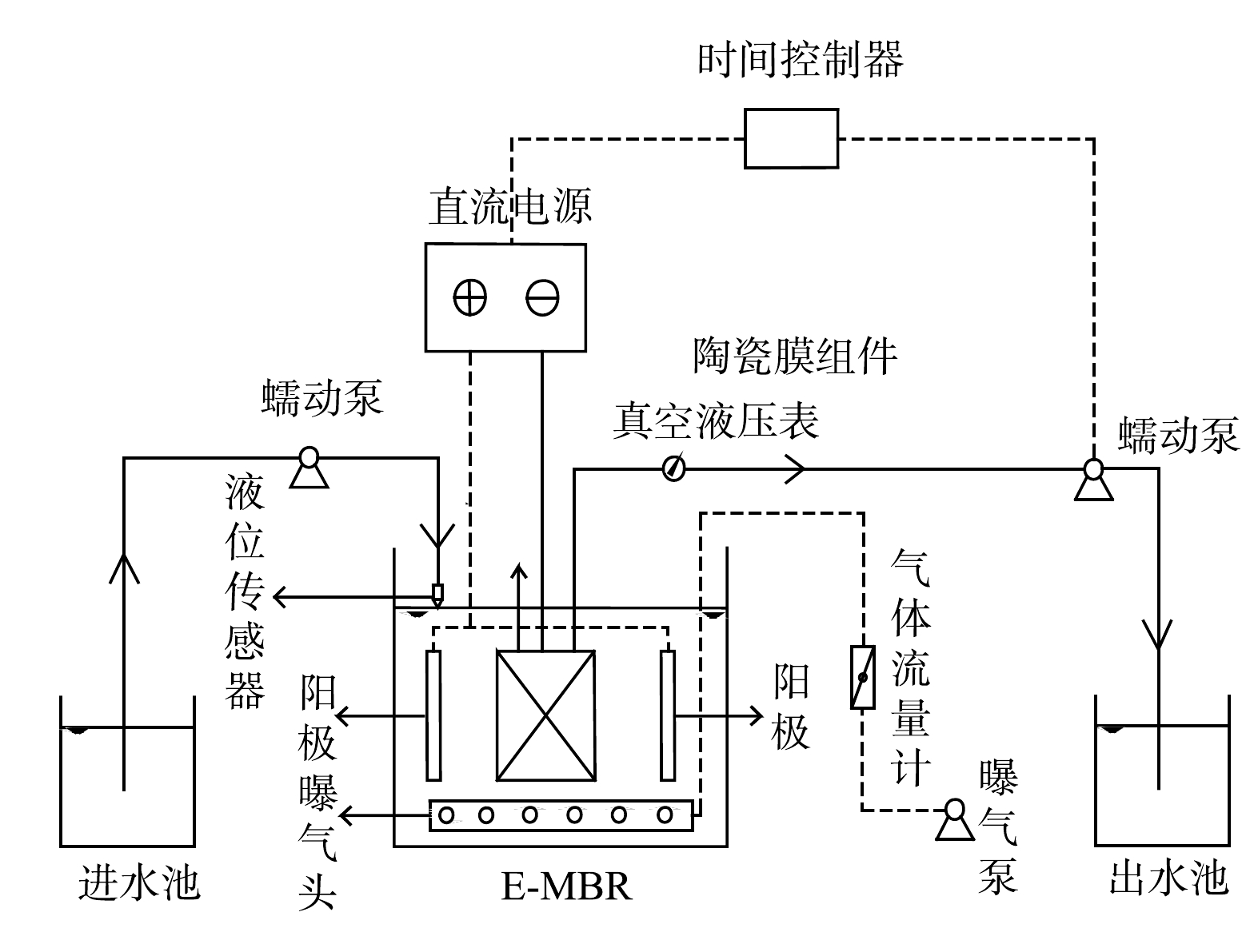
 下载:
下载:
